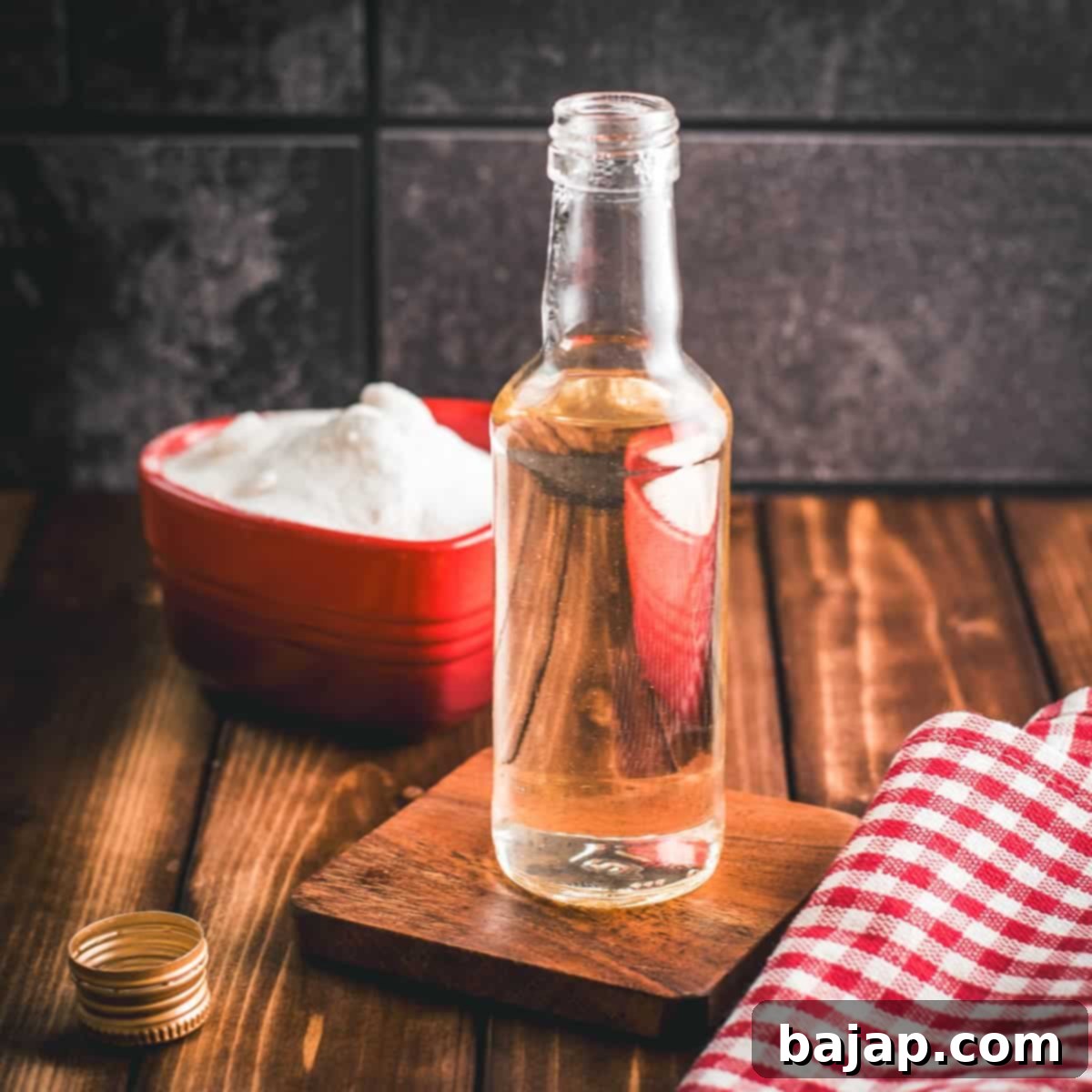Mastering Homemade Simple Syrup: The Essential Sweetener for Perfect Cocktails & Drinks
Every truly exceptional cocktail, from a classic Old Fashioned to a refreshing Gin Fizz, owes a debt of gratitude to one often-overlooked yet utterly indispensable ingredient: simple syrup. This humble blend of sugar and water might sound basic, but it’s the secret weapon that professional bartenders and home mixologists alike rely on to achieve perfectly balanced, smoothly sweetened drinks. Forget grainy sugar stubbornly refusing to dissolve in your iced beverages; simple syrup offers effortless integration and a silky texture that elevates any creation.
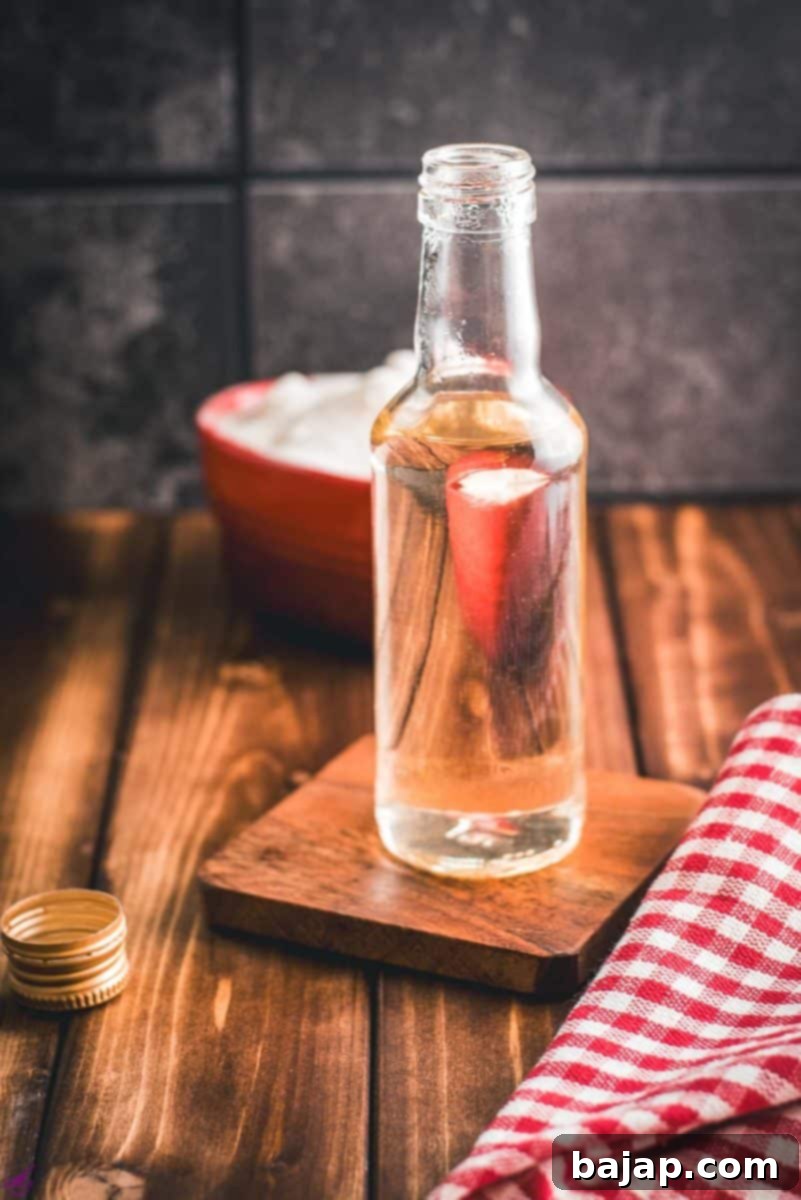
In this comprehensive guide, we’ll dive deep into the world of simple syrup. You’ll learn just how incredibly easy it is to make at home, saving you money and ensuring you always have this versatile sweetener on hand. Beyond just sweetening, simple syrup provides a smooth, liquid sugar that blends seamlessly into cold beverages, ensuring every sip is perfectly balanced. It’s not just for cocktails either – this foundational ingredient can enhance mocktails, iced coffees, teas, lemonades, and even certain desserts. Once you master the basic recipe, a whole new world of flavored syrups opens up, allowing you to infuse your drinks with endless creative possibilities.
Let’s embark on this sweet journey and discover how to craft your very own batch of this essential liquid gold!
What is Simple Syrup and Why is it Indispensable?
At its core, simple syrup is merely sugar dissolved in water. The name itself hints at its straightforward nature. While you might be tempted to just spoon granulated sugar directly into your drink, especially cold ones, you’ll quickly notice it doesn’t fully dissolve. This results in an unevenly sweetened beverage with a gritty texture. Simple syrup, however, is a liquid sweetener, meaning the sugar crystals are already broken down and fully integrated into the water. This allows for instant and uniform mixing, which is crucial for achieving a consistently delicious drink.
Its primary role in mixology is to provide sweetness without altering the texture or clouding the drink, unlike honey or maple syrup which bring their own distinct flavors. Simple syrup is a neutral sweetener, allowing the other ingredients in your cocktail to shine. It helps to balance the acidity of citrus juices and the bitterness of spirits, creating a harmonious flavor profile. For any home bar enthusiast, knowing how to make and properly use simple syrup is a foundational skill that will significantly elevate your drink-making prowess.
🥘 Essential Ingredients for Simple Syrup
You’ll be delighted to know that making simple syrup requires just two basic ingredients, both likely already in your pantry. The beauty of this recipe lies in its simplicity and accessibility.
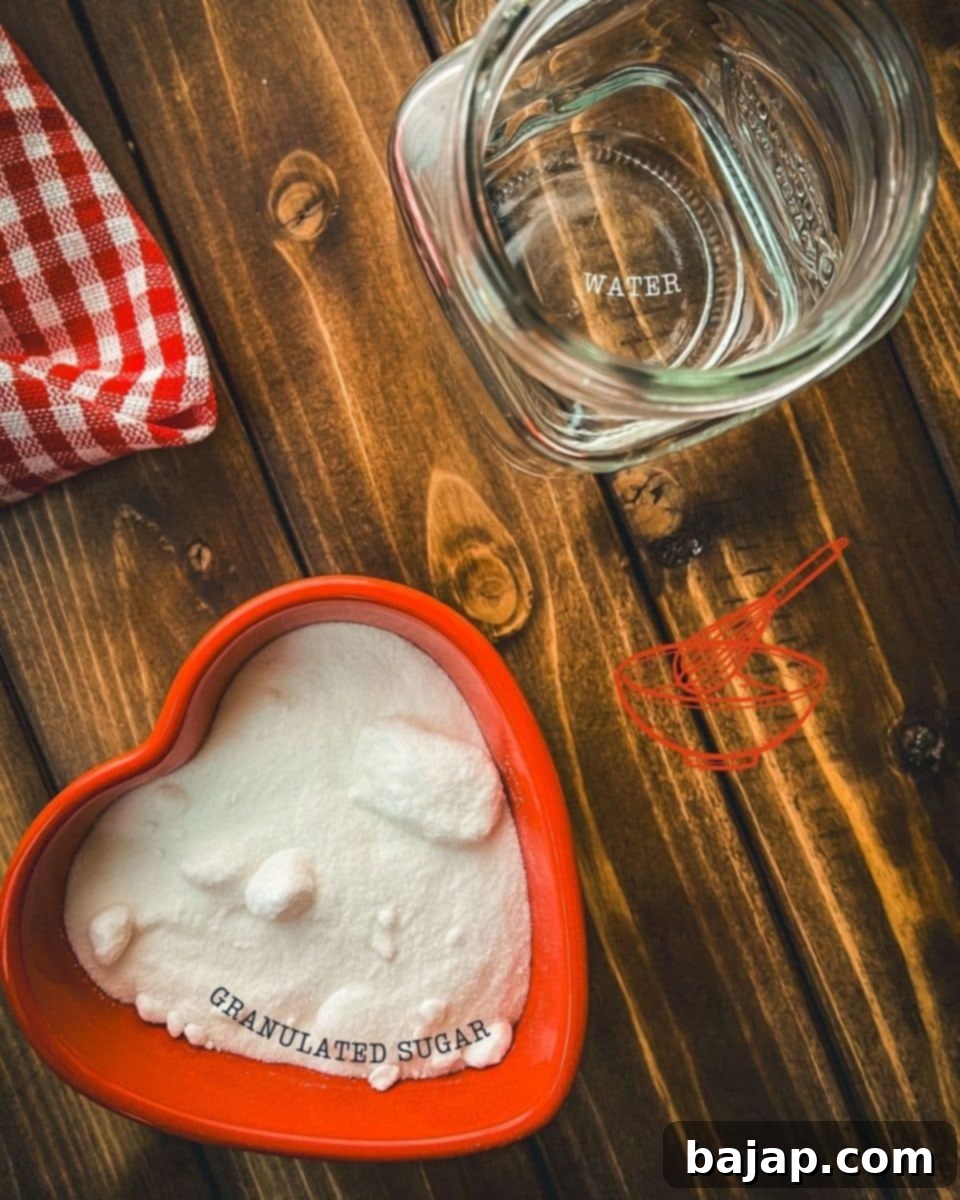
- Granulated Sugar: This is the heart of your simple syrup. While standard white granulated sugar is the most common choice, you have options!
- White Granulated Sugar: This provides a neutral sweetness, perfect for most cocktails where you don’t want to introduce additional flavors or colors.
- Brown Sugar: Creates a richer, caramel-toned syrup ideal for whiskey cocktails or autumn-themed drinks.
- Raw Cane Sugar (Turbinado or Demerara): Offers a slightly more complex, molasses-like flavor and a subtle golden hue, great for adding depth. Ensure it’s raw cane sugar for a vegan-friendly option, as some white sugars are processed with bone char.
- Rich Simple Syrup (2:1 Ratio): While the standard ratio is 1:1 (equal parts sugar and water), a “rich” simple syrup uses a 2:1 sugar-to-water ratio. This results in a thicker, more concentrated syrup that is often preferred in spirit-forward cocktails like an Old Fashioned, as it requires less liquid to achieve the desired sweetness, thus diluting the drink less.
- Water: Plain tap water will generally suffice for this easy cocktail staple. However, the quality of your water can impact the final taste and clarity of your syrup. If your tap water has a strong mineral taste or chlorine smell, consider using filtered water. This small step can make a noticeable difference in the purity of your simple syrup’s flavor.
For precise quantities and a printable recipe card, please refer to the recipe card at the bottom of this article.
🍯 How to Make Simple Syrup: A Step-by-Step Guide
Making simple syrup is incredibly straightforward, requiring minimal effort and time. Follow these simple steps to create your own batch of this bar essential.
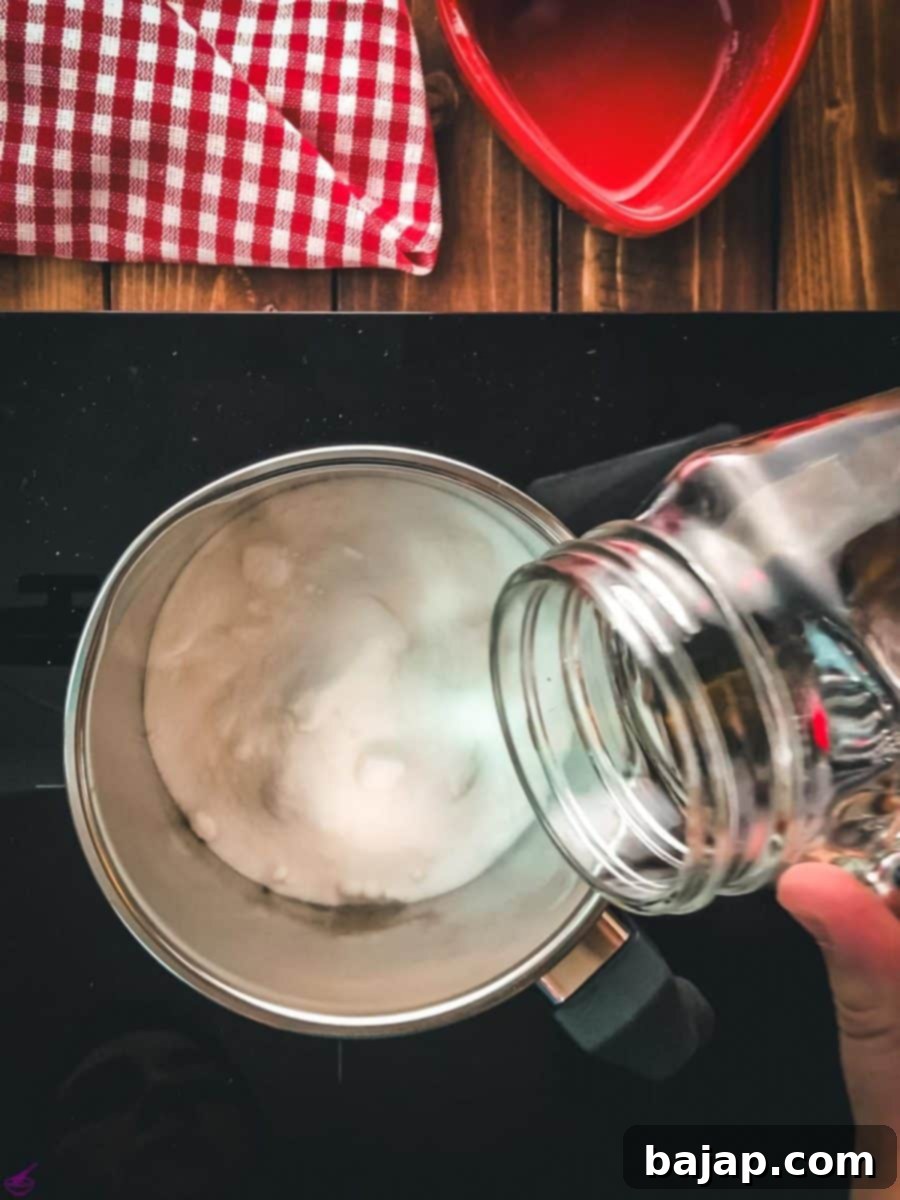
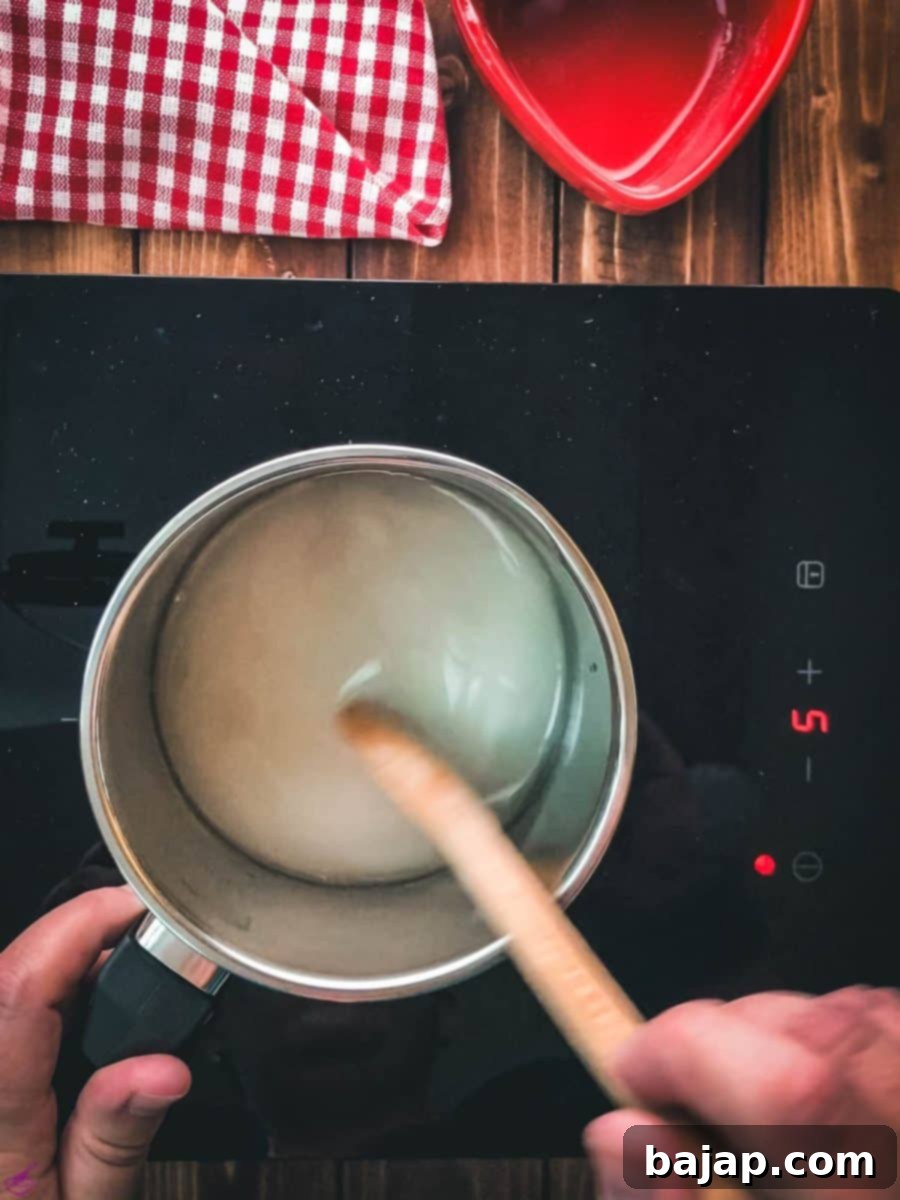
Step One: Combine and Dissolve. In a small saucepan, combine your granulated sugar and water. Place the saucepan over medium heat. Bring the mixture to a gentle boil, then immediately reduce the heat to a simmer. Stir continuously with a wooden spoon or whisk until all the sugar crystals have completely dissolved and the mixture has a clear, syrupy consistency. It’s crucial not to let it boil vigorously for too long, as this can cause too much water to evaporate, leading to a thicker syrup or even crystallization later. A minute or two of simmering with stirring is usually sufficient.
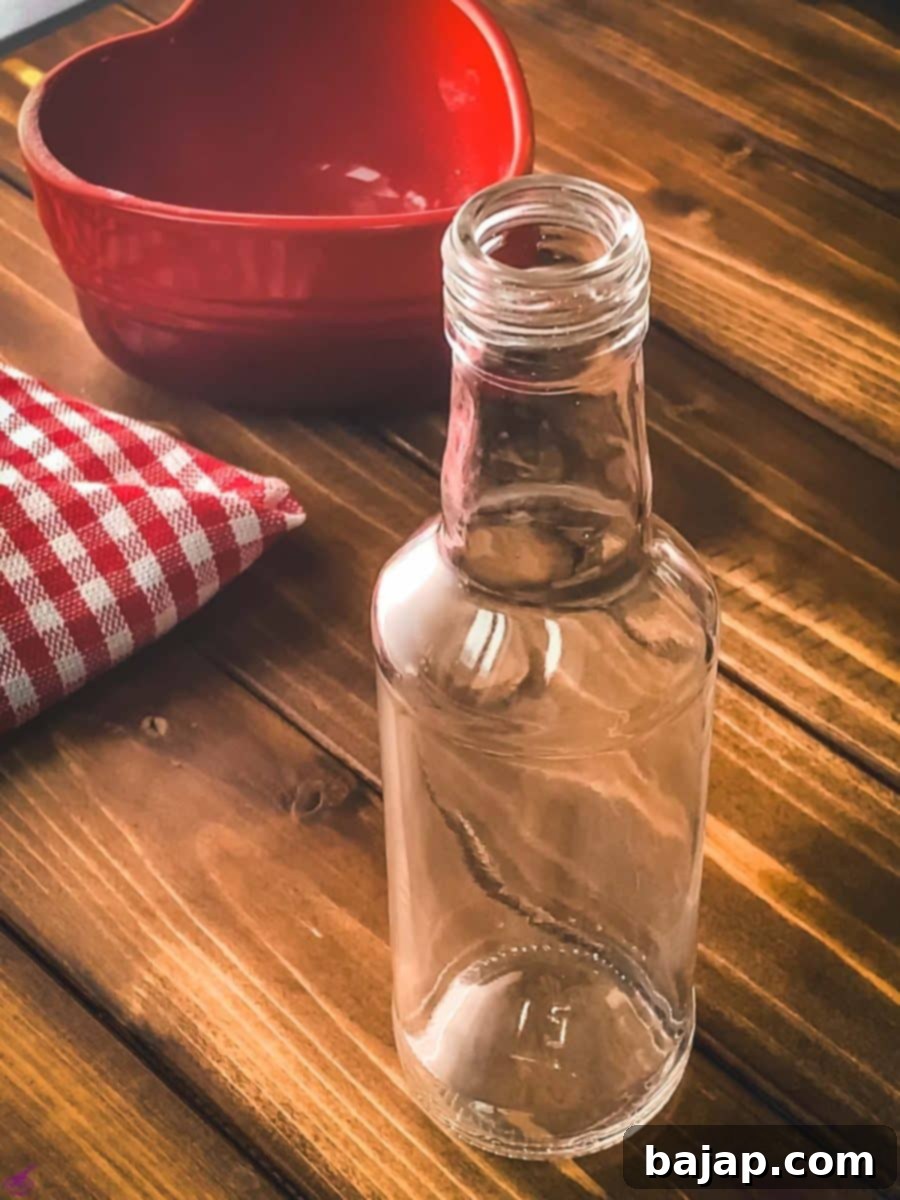
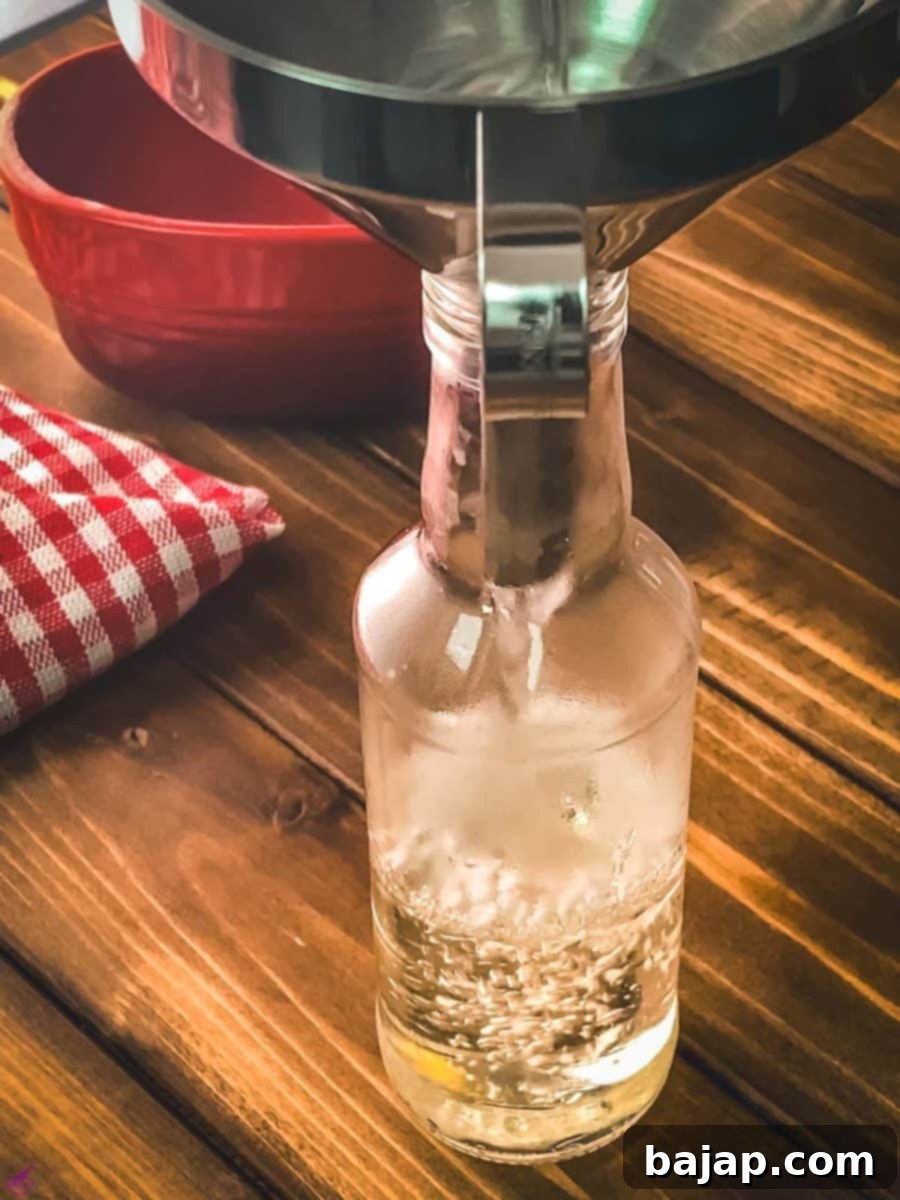
Step Two: Cool and Transfer. Once the sugar is fully dissolved, remove the saucepan from the heat. Allow the simple syrup to cool completely to room temperature. This step is important for safety and for preventing condensation inside your storage container, which could introduce unwanted moisture. Once cooled, carefully pour the syrup into a clean, sterilized container. A funnel can be very helpful here to avoid spills.
Step Three: Store and Enjoy. Seal your container tightly and store the simple syrup according to the guidelines below. It’s now ready to be used in an endless array of delicious cocktails, mocktails, and other beverages!
🌡️ How to Store Simple Syrup and Maximize Shelf Life
Proper storage is key to keeping your homemade simple syrup fresh and delicious for as long as possible. Once your syrup has cooled completely, transfer it into a clean, airtight container. Glass jars or bottles with tight-fitting lids are ideal. While simple syrup can technically be stored at room temperature for a short period, refrigerating it is highly recommended to significantly extend its shelf life.
Refrigeration: When stored in an airtight container in the refrigerator, 1:1 simple syrup typically lasts for about 2-4 weeks. Rich simple syrup (2:1 sugar-to-water ratio) tends to last longer, often up to a month or more, due to its higher sugar concentration which acts as a natural preservative. Always make sure your container is impeccably clean before pouring the syrup in to prevent contamination.
Signs of Spoilage: Keep an eye out for any signs that your simple syrup has gone bad. These include:
- Cloudiness: If your clear syrup becomes cloudy, it’s a sign of bacterial growth.
- Mold: Any visible mold, no matter how small, means it’s time to discard the batch.
- Off-smell: A sour or unpleasant odor indicates spoilage.
- Crystallization: While not a sign of spoilage, if your syrup develops sugar crystals, it means the sugar has started to separate from the water. You can sometimes remedy this by gently reheating and stirring, but it’s often a sign that the syrup is past its prime.
It’s always better to be safe than sorry – if you suspect your syrup has spoiled, toss it and make a fresh batch!
🍯 Substitute for Simple Syrup: Alternatives and Considerations
Simple syrup is indeed the gold standard for sweetening many classic drinks due to its neutral flavor and smooth texture. However, if you’re looking for alternatives or trying to achieve a different flavor profile, several substitutes can be used. Just remember that each alternative will bring its own unique characteristics to your drink, potentially altering the intended flavor of a classic cocktail.
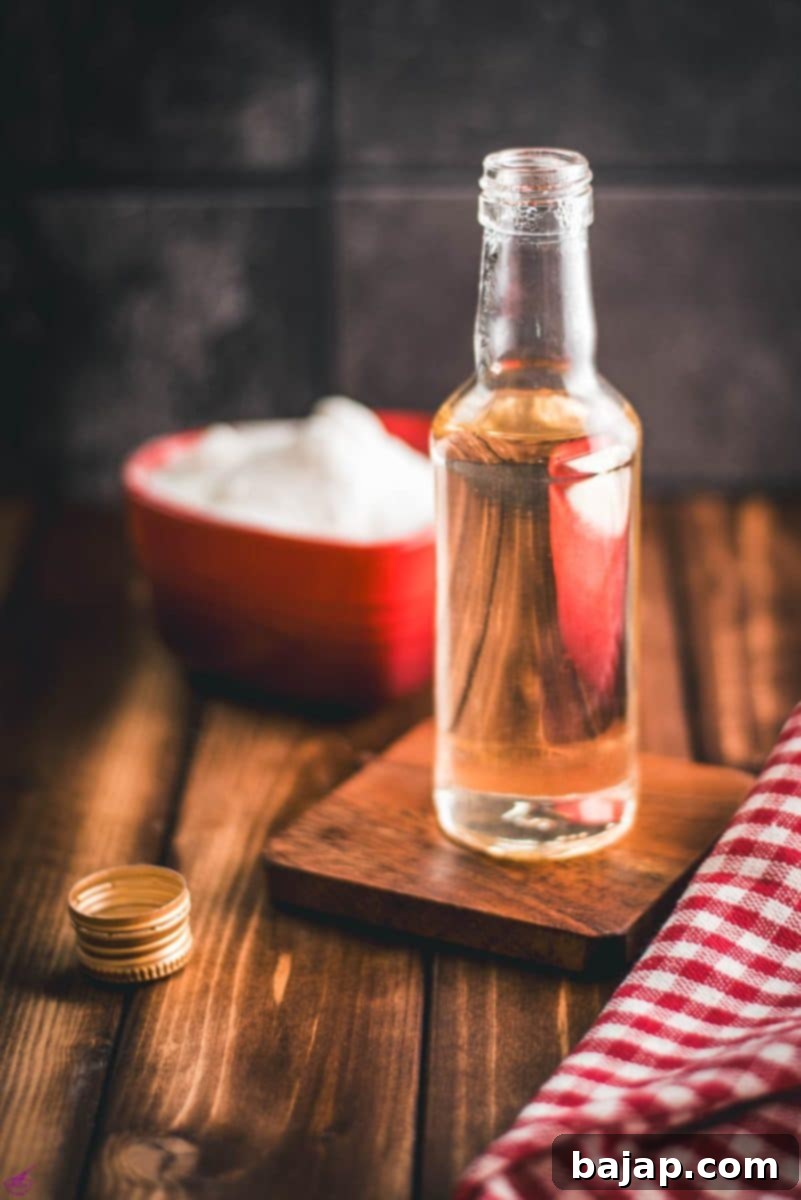
- Agave Nectar: A popular choice, especially for those looking to cut down on refined sugar or for a vegan option. Agave nectar is sweeter than sugar, so you’ll typically use about 2/3 the amount of simple syrup. It has a relatively neutral flavor, making it versatile for many drinks.
- Honey: Honey offers a distinct floral or earthy sweetness, making it an excellent choice for cocktails that pair well with its unique flavor profile, such as those with whiskey or gin. Because honey is quite thick, it’s often best to dilute it into a “honey syrup” (equal parts honey and hot water, stirred until combined) before using in cold drinks to ensure smooth mixing.
- Maple Syrup: With its characteristic robust flavor, maple syrup is fantastic for autumnal or warming cocktails. Like honey, it’s naturally thicker than simple syrup, so consider a “maple syrup” (equal parts maple syrup and hot water) for easier incorporation.
- Stevia, Erythritol, or Monk Fruit Syrups: For those on a sugar-free diet, commercially available liquid sweeteners like stevia, erythritol, or monk fruit syrups can be used. These vary greatly in sweetness and taste, so always start with a small amount and adjust to your preference. You can also make your own sugar-free simple syrup by dissolving granular sugar substitutes (like erythritol or xylitol) in hot water, just like regular simple syrup.
While these alternatives provide sweetness, remember that simple syrup’s pure, unadulterated sweetness is precisely what makes it so valuable in classic cocktail recipes. When in doubt, stick to the original for authentic flavors.
🍸 Simple Syrup In Cocktails & Beyond: Versatile Uses
The true magic of simple syrup lies in its incredible versatility. It’s the silent hero in countless beverages, effortlessly blending into both alcoholic and non-alcoholic creations. Its liquid form ensures uniform sweetness and a professional finish that granulated sugar simply can’t achieve, especially in cold drinks.
In Cocktails: The Essential Bar Staple
Simple syrup is a cornerstone of mixology, present in virtually every well-stocked bar and countless cocktail recipes. It provides that perfect touch of sweetness to balance tart citrus, strong spirits, and bitter liqueurs. Unlike raw sugar which can sit undissolved at the bottom of your glass, simple syrup instantly integrates, ensuring a consistent flavor from the first sip to the last. Some iconic cocktails that rely on simple syrup include:
- Old Fashioned (especially with rich simple syrup)
- Long Island Iced Tea
- Mai Tai
- Gin Fizz
- Mint Julep
- Daiquiri
- Margarita
- Whiskey Sour
- Mojito
- And so many more!
Mastering homemade simple syrup means you’ve unlocked the potential to create a vast array of classic and modern cocktails with confidence and finesse.
Beyond Cocktails: Sweetening Everyday Drinks and Treats
The utility of simple syrup extends far beyond the realm of alcoholic beverages. Its clean sweetness and easy miscibility make it ideal for:
- Mocktails and Lemonades: Create perfectly sweetened virgin cocktails, homemade lemonades, or iced teas without any grainy residue.
- Coffee and Tea: Say goodbye to undissolved sugar at the bottom of your iced coffee or cold brew. A dash of simple syrup provides instant sweetness.
- Fruit Salads: A light drizzle can enhance the natural sweetness of fresh fruit without overpowering it.
- Baking and Desserts: Use it to moisten cake layers, glaze pastries, or sweeten fruit compotes.
- Marinades: A touch of simple syrup can add a subtle sweetness to savory marinades, balancing other flavors.
Elevate Your Creations with Flavored Simple Syrups
Once you’ve mastered the basic simple syrup, the real fun begins with infusing it with different flavors! This is where you can truly get creative and tailor your syrups to specific drinks or seasons. The process is simple: add your chosen flavoring agent to the sugar and water mixture while it simmers, then strain it out after cooling. Some popular ideas for flavored simple syrups include:
- Herbal: Mint, basil, rosemary, thyme (perfect for mojitos, gin cocktails, or even a unique lemonade).
- Spiced: Cinnamon, star anise, ginger, vanilla (great for autumnal drinks, coffee, or hot toddies).
- Fruity: Berries (strawberry, raspberry, blueberry), citrus zest, peach, cranberry (ideal for bright, refreshing cocktails and mocktails). For a delicious example, try my easy, flavorful Strawberry Simple Syrup Recipe!
- Floral: Lavender, rose (adds an elegant touch to delicate drinks).
The possibilities are truly endless, allowing you to continually experiment and discover new flavor combinations for your beverages.
🍽 Equipment You’ll Need
You won’t need any specialized kitchen gadgets to make simple syrup. Most of the equipment you’ll need you probably already own, making this an even easier process.
- Measuring Cup: Essential for accurately measuring your sugar and water, ensuring the correct ratio for your syrup.
- Small Saucepan: A non-reactive saucepan (stainless steel or enameled cast iron) is perfect for combining and heating the ingredients.
- Wooden Spoon or Whisk: For stirring the mixture to ensure the sugar dissolves completely and evenly.
- Preserving Jar, Bottle, or Airtight Container: Once cooled, you’ll need a clean, airtight vessel to store your finished simple syrup. Glass bottles or jars are preferred for their non-reactive nature and ability to be sterilized.
- Funnel (Optional but Recommended): A funnel makes pouring the cooled syrup into a narrow-necked bottle much easier and mess-free.
🙋🏻 Frequently Asked Questions (FAQ)
Yes, absolutely! You can easily trade traditional granulated sugar for a granulated sugar-free sweetener such as erythritol, xylitol, or a blend. Simply prepare the syrup following the exact same ratio and method outlined in the recipe. Adjust to taste as the sweetness levels of sugar substitutes can vary.
You certainly can! Freezing simple syrup is an excellent way to extend its shelf life even further, up to three months or more. Just pour the cooled simple syrup into ice cube molds and freeze until solid. Once frozen, you can transfer the syrup cubes to a freezer-safe bag or container. This is a convenient way to portion out your syrup for future use – just thaw a cube or two as needed for your drinks!
The numbers refer to the ratio of sugar to water. A 1:1 simple syrup uses equal parts sugar and water, resulting in a lighter, less viscous syrup. A 2:1 simple syrup, also known as “rich” simple syrup, uses two parts sugar to one part water. This makes a thicker, sweeter, and more concentrated syrup. Rich simple syrup is often preferred in spirit-forward cocktails because you need less of it to achieve the same sweetness, which reduces dilution.
Other Delicious Cocktail & Drink Recipes to Explore
Now that you’re armed with the knowledge of how to make perfect simple syrup, it’s time to put it to good use! Explore some of our other fantastic drink recipes:
- Peach Moscow Mule with Homemade Peach Purée
- Austrian Zirben Spritzer – White Wine Spritzer with Pine Liqueur
- Peach Purée for Bellini (and More!)
- Bourbon Highball
If you try this recipe, we’d love to hear from you! Please consider rating it with ★★★★★ stars and leaving a comment below to share your experience. Your feedback is invaluable! You can also sign up for our Newsletter for weekly delicious homemade recipes or follow us on Pinterest or Instagram. Don’t forget to tag us @combinegoodflavors and use the hashtag #combinegoodflavors so we can see your fantastic creations!
📖 Simple Syrup Recipe
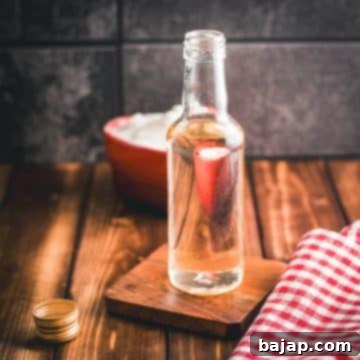
How to make Simple Syrup
Nora
Save RecipeSaved!
Pin Recipe
Equipment
-
Measuring cup
-
Saucepan
-
Stove
-
Wooden spoon or Whisk
-
Preserving jar or bottle (airtight container)
-
Funnel (optional)
Nutrition values are estimates only, using online calculators. Please verify using your own data.

🤎 You Might Also Like These Recipes
Don’t stop at simple syrup! Continue your culinary and mixology adventures with these other enticing recipes:
- Festive Cranberry Gin and Tonic
- Fall in Love with this Cranberry Bundt Cake
- Homemade Vodka Sidecar
- Gin and Tonic with Lemon
⛑️ Food Safety Guidelines
When preparing any food or beverage, especially those with sugar, it’s important to keep food safety in mind to ensure your homemade simple syrup is not only delicious but also safe to consume. These general guidelines apply:
- Cook to a minimum temperature of 165 °F (74 °C) to eliminate potential bacteria. While simple syrup is mostly sugar and water, ensuring it comes to a boil is a good practice.
- Do not use the same utensils on cooked food that previously touched raw ingredients without proper cleaning.
- Always wash hands thoroughly before and after handling any food ingredients.
- Don’t leave food sitting out at room temperature for extended periods. Cool simple syrup promptly after preparation and refrigerate as recommended.
- Never leave cooking food unattended on the stove.
- Use oils with high smoking points to avoid harmful compounds if you are cooking other recipes.
- Always ensure good ventilation when using a gas stove.
For further comprehensive information on safe food handling practices, please refer to reliable sources such as the Safe Food Handling – FDA.
